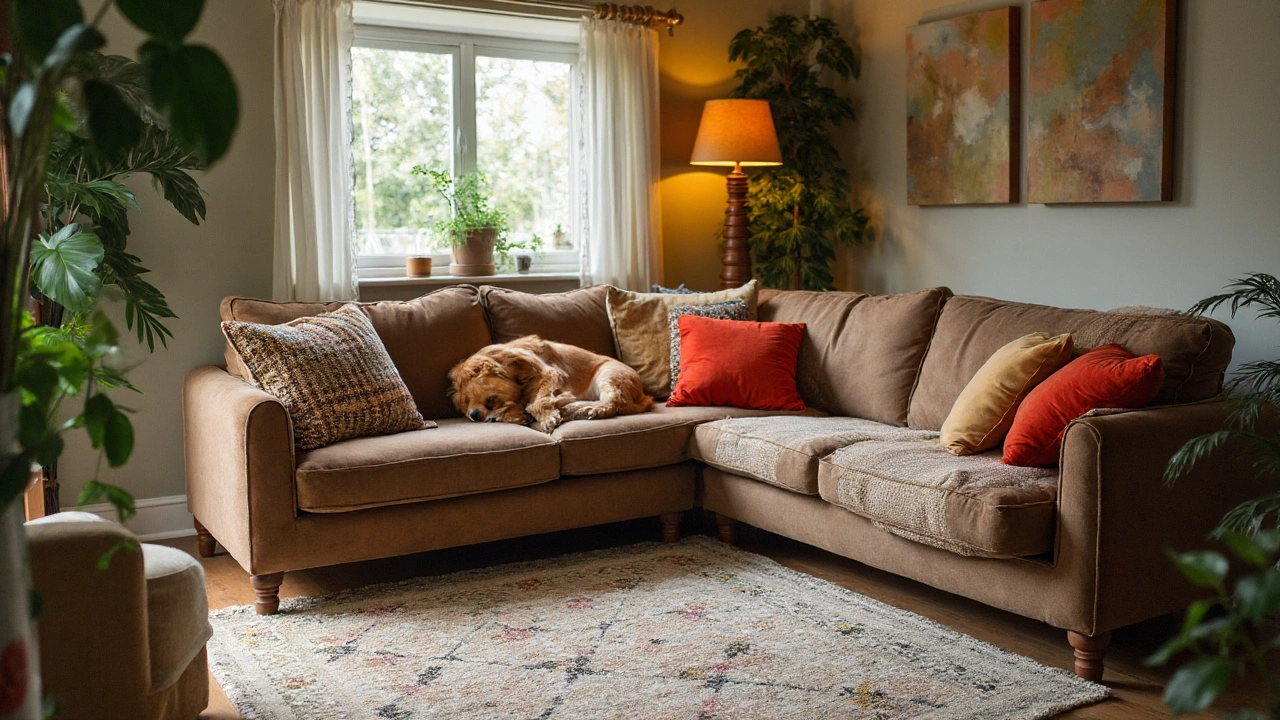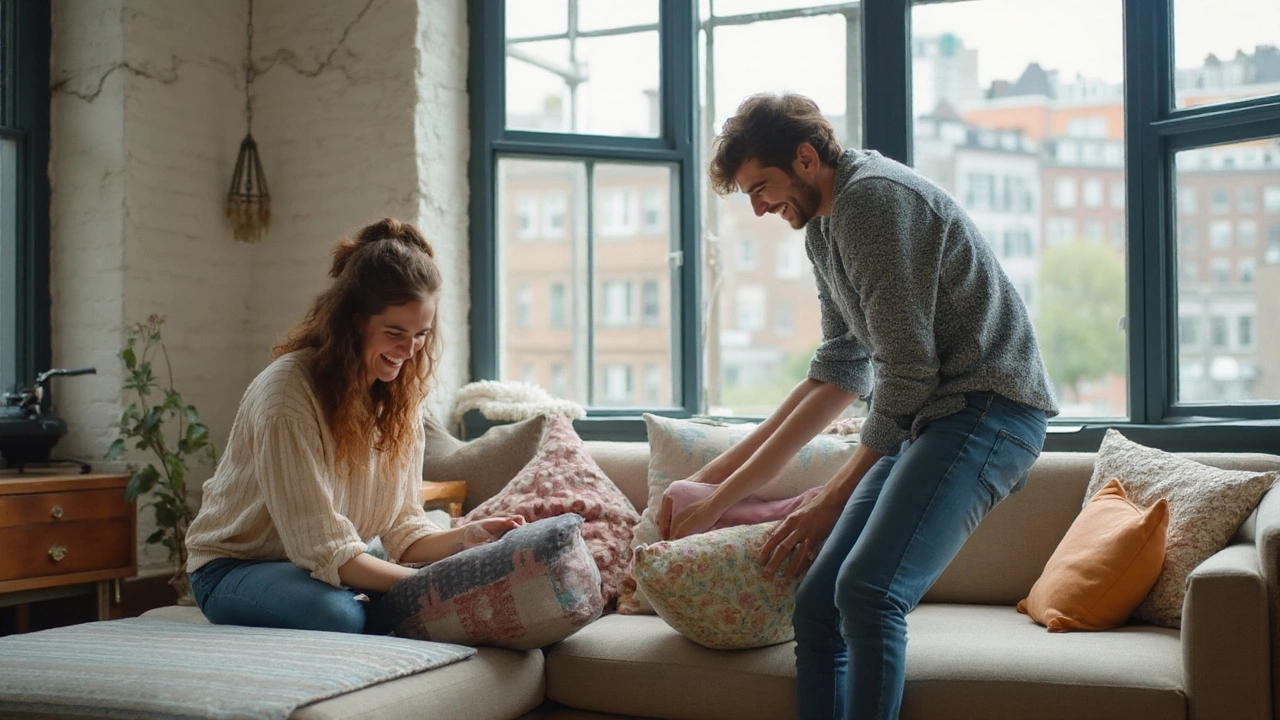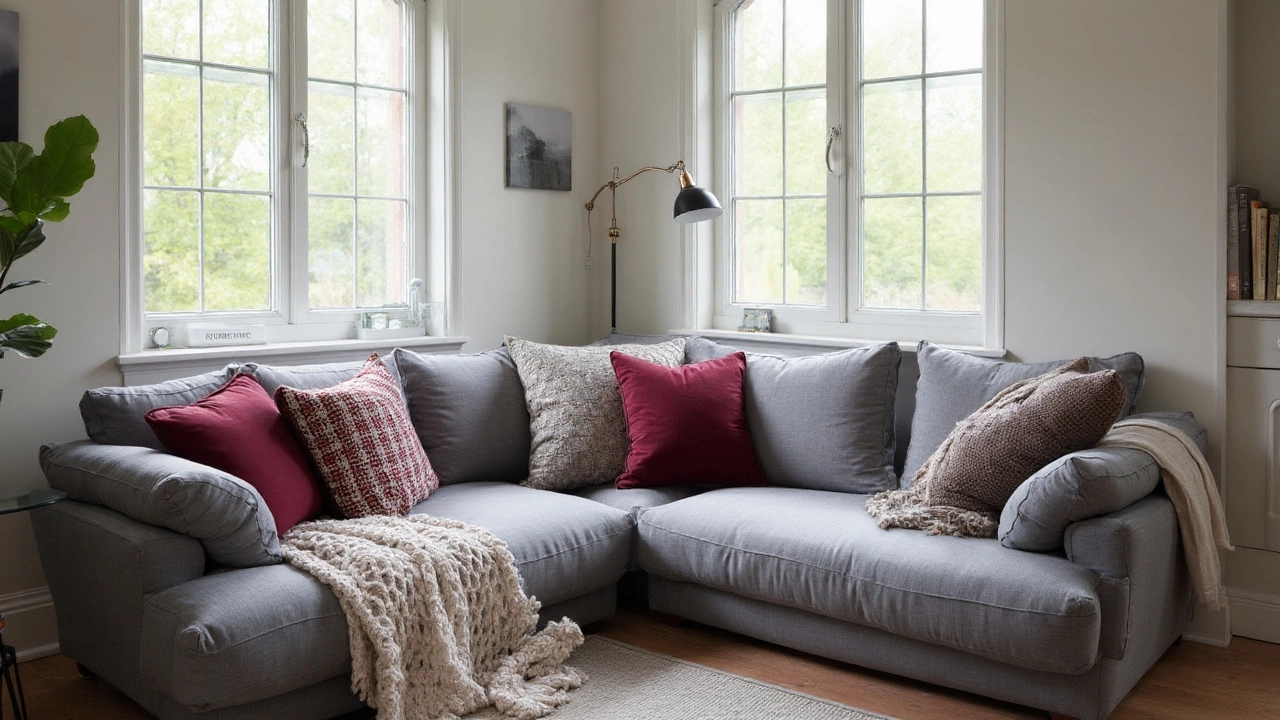Picture this: You’ve just splashed out on a beautiful new corner sofa. It’s so inviting, you’re half-tempted to dive onto it fully dressed, shoes and all. But before you go full Goldilocks and crash into the cushions, you’re hit with one of those oddly specific modern problems—where do the actual cushions go? Is there a right way or is it just a free-for-all? As weird as it sounds, arranging cushions on a corner sofa is like a silent art. It can actually change how your living room feels and looks, how you relax, and even how people see your place. There’s a science to this comfort. So, let’s get into the nitty-gritty of what works, what looks strange, and how you can master the perfectly styled corner sofa—without buying a single extra cushion (unless you want to, of course).
Understanding the Layout: Why Cushion Placement Matters
Most people don't realise it, but the layout of your cushions can either make your corner sofa a showstopper or turn it into something that just looks a bit, well, off. The traditional three-seat straight sofa? Dead easy. You plonk a cushion at either end and, if you’re feeling wild, chuck a third in the middle. Corner sofas, though, that’s another game. You get that classic L-shape or sometimes even a U, and suddenly, there’s a mysterious corner that causes more confusion than your grandma’s cryptic crossword clues.
Why does it matter? For starters, a corner sofa usually becomes the room’s anchor. It sets the tone for the space—stylish, chilled, inviting, or badly planned. Get the cushions right and the entire sofa feels cosier, more put-together. According to a survey by the British Furniture Confederation in May 2023, over 60% of people said the look and comfort of their sofa determined whether they’d use their living room or just stick to the kitchen. Surprisingly, 1 in 4 admitted to hiding unwanted cushions in cupboards before guests arrived. Cushion placement isn’t just about what looks nice—it helps you relax properly. The right arrangement keeps your back comfortable and gives your guests a clear invite to plop down wherever they want.
Let’s talk about that awkward corner section. Some folks pile up cushions right in the corner, creating a plush mountain. Others keep it empty so someone can actually sit there. The trick? Think about who usually sits on your sofa, how often, and if you use it just for TV time or to entertain mates. If you like stretching out and napping, you’ll want more support in the arms and the corner. If you often pack the sofa with guests, keep the seating spaces open with smaller or fewer cushions to avoid that ‘I’m wrestling a cloud’ feeling.
Another known fact: the average corner sofa in UK living rooms is roughly 2.6 metres along each arm. That’s plenty of space for, say, five to six seat cushions, but most of us end up using two per side, because we worry about overcrowding. Here’s a tip: you’re not limited by the number of sofa seats. Mix it up with cushions in different sizes—a couple of large ones for support, a few smaller decorative ones for that made-it-look-easy style, and maybe a long lumbar cushion bridging the two sides in the corner. This layering feels less rigid than the usual one-cushion-per-seat formula.
Notice how lifestyle magazines show corners with statement cushions or throws? That’s because interior designers use the corner part as the spot to anchor the rest of the layout. When in doubt, anchor your largest or boldest cushion in the corner and fan out the smaller ones from there. This draws the eye through the L-shape and avoids making the corner look like accidental furniture Tetris. You can even ditch symmetry—odd numbers of cushions (like five or seven) instantly make a corner sofa look less uptight and more ‘had a great idea after coffee’ chic.

Arranging Cushions Like a Pro: Styles and Practical Tips
There’s no official ‘Cushion Police’ telling you what to do, but there are a few styles that just work. It comes down to how you want your room to feel—cosy and layered or clean and minimal? Either way, some common sense and proven tips help cut the chaos.
The quickest hack: Start big and go small. Place your largest, plumpest cushions at the back—usually at the ends of the sofa and right in the corner where the two arms meet. This creates back support and instantly gives the sofa a plush look. Work your way forward with medium and smaller cushions. A classic combo is this: two or three large cushions for each ‘arm’ section, one statement cushion in the very corner (could be square, rectangle, or even round), then two or three smaller accent cushions in front or dotted about. Work in threes and fives when possible—odd numbers look more relaxed. The British House & Home Style Index from early 2025 actually found that 64% of home decor bloggers favour layouts that avoid perfect symmetry because they feel more ‘liveable.’
Go for contrast in both texture and pattern but keep a subtle link—a similar shade, repeating pattern, or trim. For example, if your corner sofa is a soft grey, add cushions with textured knits, velvets, or chunky weaves in mustard, dark green, or muted navy. Think of your sofa like a blank canvas. Throw a faux fur cushion or two into the mix for winter. In summer, swap for linen or soft cotton for a lighter feel. Don’t put the exact same cushion on every section, or it starts to look like a showroom rather than a home. Mix up sizes: standard (45x45cm is common on UK sofas), plus a couple of 60x60cm giants or 30x50cm rectangles for the corner.
Experimenting with diagonal layouts in the corner adds depth and doesn’t force cushions into awkward bunches. Put a chunky cushion at a slight angle in the corner, and let two slightly smaller ones lean on it to either side. This creates a natural flow and makes the corner extra inviting—no more wasted space. If you love uniformity, that’s fine, but lifted corners and angled cushions stop the sofa from looking too flat.
What about special functions? Got pets or young kids? Use cushion covers you can easily take off and wash. Or, go for dark, tightly woven fabrics that repel pet hair and stains. If your corner sofa is modular or you often reconfigure it, don’t wedge too many cushions into the corner—keep them easy to move or store. A soft storage basket near the sofa can double as a temporary home for extra cushions when you’re expecting a full house.
And don’t forget about throws. Drape a throw blanket loosely over one of the sofa arms and tuck the end behind a cushion, or let it drape along the corner section. This not only adds another layer of texture but also offers a super practical bonus: more warmth for those chilly Birmingham nights (since let’s face it, those happen even in August). The trick is to avoid folding throws perfectly or making everything look staged. Cushions and throws should look like you live there, not like you’re waiting for a magazine photographer.
Many people skip thinking about cushion filling, but it can make all the difference. Synthetic fibre stays plump and bouncy, while feather and down give that slouchy luxury vibe (and demand more fluffing). Some of the comfiest setups on Instagram use a mix of both for back support and slouch-friendly naps. The British Council for Interiors expects the use of recycled cushion fillings to jump by 30% next year, as eco-friendly decor becomes even bigger. If you like doing your bit for the environment, search out brands offering recycled or upcycled cushion stuffing—lots of indie shops in Birmingham have started carrying these as standard.
For the bold, try an oversized floor cushion beside the corner section for added seating or just a place to pop your feet up. These work especially well if the sofa isn't against a wall, opening up the design and giving everyone more lounging space. Speaking of walls, if your sofa is right up against one, don’t crowd the back with too many cushions—leave room for people to sink in.
To sum up: treat your sofa like it’s there to help you relax, show off a bit of your personality, and make the space more inviting. Try, tweak, live with it—and if you hate it after a week, swap the whole lot around. You’re in charge.

Styling for Every Mood: Personalising Your Corner Sofa
No two households use their living spaces the same way, so there’s no single rulebook. It’s a bit like how some people actually love Marmite; others don’t want it anywhere near them. So, what are you aiming for—max comfort, easy clean-up, a room that wows your mates, or just a relaxing solo crash pad?
If relaxation is your endgame, think oversized, soft cushions that you can practically sink into. Fill the corner with at least two of your biggest cushions, then flare outwards with supports on both sides. Mix in a textured throw or a bolster, and you’ve got the ultimate Sunday afternoon nap spot. For the more minimalist types, keep it sleek and fuss-free. Two or three high-quality cushions in coordinating colours along the longer arm give structure without clutter. The Abbey Road Home Design Studio, in a February 2025 feature, pointed out that the average person stands in their living room doorway and judges ‘how clean or chaotic’ it looks within six seconds – so less is definitely sometimes more.
If you’ve got little kids or rambunctious pets, go for durability over fluff. Removable, hard-wearing covers that are easy to wash and quick to swap are a lifesaver. Position the largest cushions at the ends where spills are more likely, and use slightly firmer, stain-hiding cushions in the middle and corner. Want a chilled family movie night? Stack up the cushions in the corner and let everyone grab their own for a makeshift pillow fort.
Want some wow factor when friends come over? Mix up bold prints, metallic accents, or unexpected shapes. That doesn’t mean turning your living room into a circus, but one or two punchy cushions in chevrons, geometrics, or velvet can break up the monotony. Place them at the corner and offset with plainer, soft-toned cushions on the arms. It’s a neat way to start conversations (or at least get a nod from your stylish mates).
Another styling tip from design insiders: change up with the seasons. Winter begs for warm, chunky knit or faux fur cushions, and richer tones like forest green or deep burgundy. Summer’s perfect for linens, pastels, or subtle patterns like faded stripes. Rotate your cushion covers every few months to keep the room feeling new without buying everything from scratch. Keep the same base cushions, and just switch covers for instant change.
If your sofa links directly to an open-plan dining area, use your cushions to echo accent colours or styles from nearby rooms. Grab inspiration from art you’ve hung or a rug you love. This little touch ties the space together, making your living area feel purposeful instead of just thrown together. If you find yourself with cushions leftover and nowhere else to put them, they’ll double as floor seating for parties or impromptu board games.
Don’t obsess over perfection. The coziest homes are the ones that look like someone actually lives there. If your cushions lean or shift every time someone sits down, that’s alright—it just means they’re being used. The most important thing to remember: it’s your space, your sofa, your comfort. The secret is simply putting the cushions where they work for you, using a few easy tricks to make that corner sofa the centre of everything—from lazy days to unexpected guests dropping by. Forget the ‘rules’ and trust your eye. After all, you’re the one who’ll be flopping down, book in hand, after a long day. And isn’t that kind of the whole point?


Write a comment